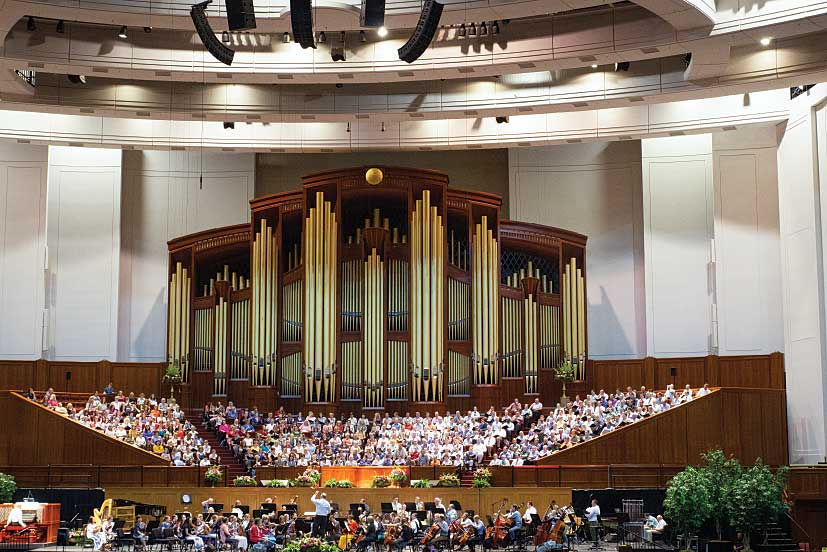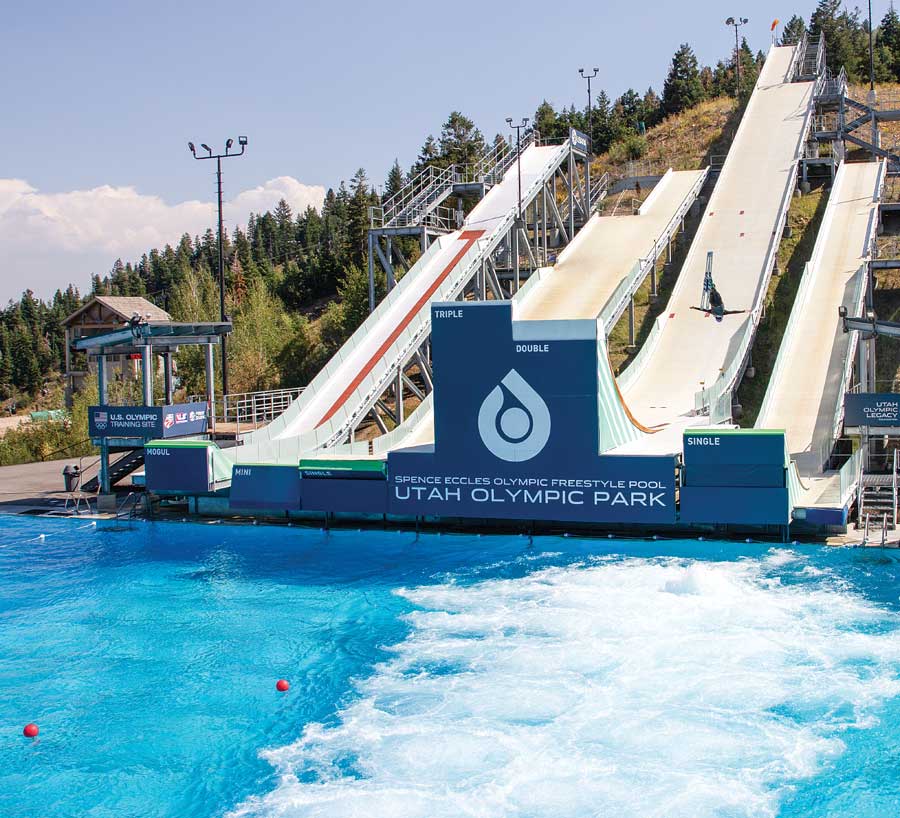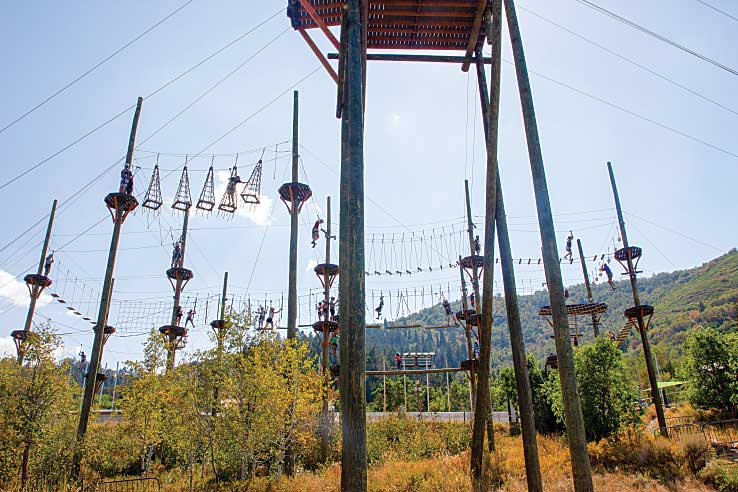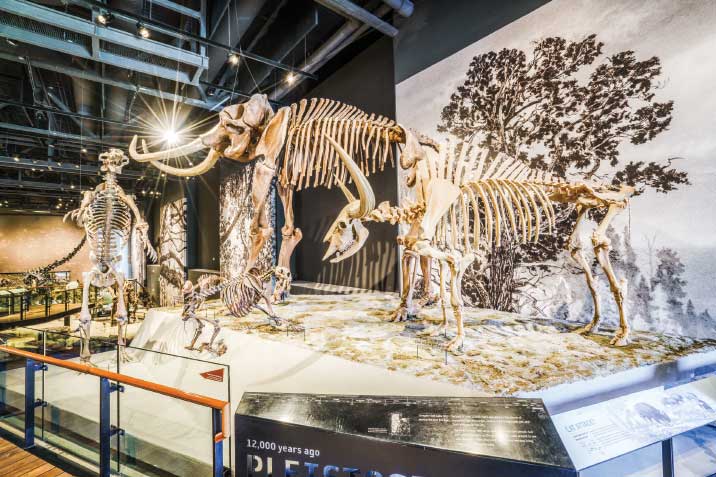From its world-famous Tabernacle Choir to Olympic training facilities to scenic biking trails to the Family History Library, Utah’s Salt Lake City area is ripe for exploration
In 1987, my husband, Jim, and I came to Utah for the first time to mountain bike. We fell in love with the state and have returned at least once a year — sometimes twice — to mountain bike, golf and ski. We’ve also visited its five national parks and some of its seven national monuments and three national recreation areas. Last summer, for the second time in 30 years, we spent time in Salt Lake City. In this state well-known for its natural beauty and outdoor recreation, it stands to reason that its largest city would have ample man-made beauty and fascinating attractions as well.
We checked in at the Pony Express RV Resort & Campground in North Salt Lake. While it has well-manicured RV sites, a swimming pool and clubhouse, my favorite feature was its close proximity to the Jordan River Parkway Trail. The 45-mile paved trail parallels the Jordan River as it flows north from Utah Lake to the Great Salt Lake. As soon as we were settled in, we hopped on our bikes to get our bodies moving after the long drive.
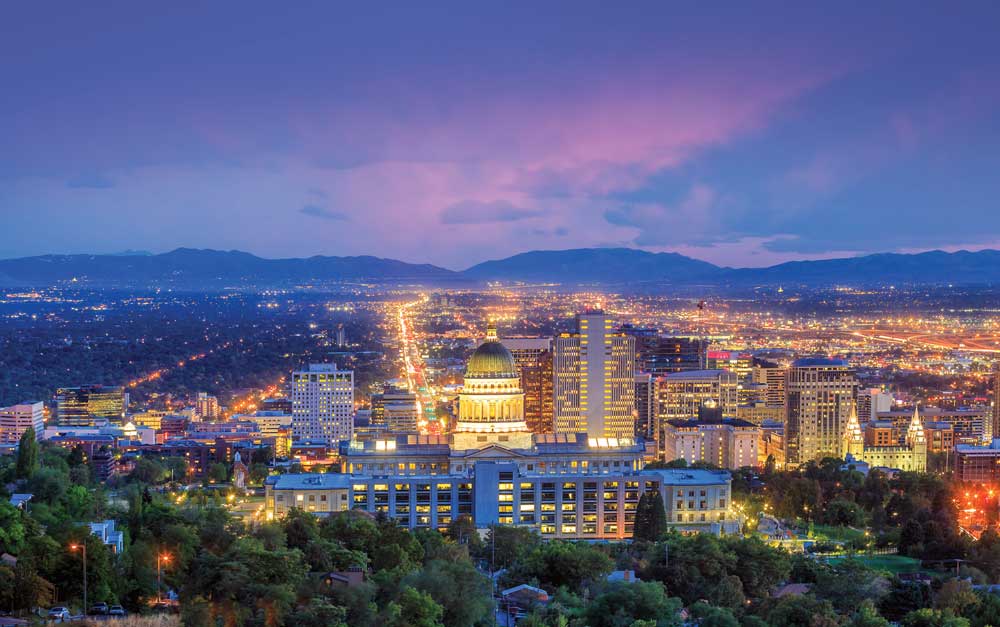
Construction on Utah’s Capitol building was completed in 1916. Today it is part of the state’s Capitol Hill Complex, which includes Senate, House and state office buildings.
Photos: Mary and Jim Zalmanek
Since the Mormon Tabernacle Choir rehearsals are open to the public most Thursday evenings, it was serendipitous that we arrived on a Thursday. We drove our dinghy vehicle to Temple Square to hear the 360-member chorus of men and women. The choir is “dedicated to the universal language of music that has the power to bring joy, peace and healing to its listeners … (which) transcends cultural and generational boundaries and brings together people from around the world through stirring music.” Almost as impressive as the choir itself, a 7,708-pipe organ dominates the wall behind the choir and orchestra in the Conference Center.
Before and after the rehearsal, we toured some of the other buildings in Temple Square. In the South Visitors’ Center, a scale model shows details of the Salt Lake Temple, which was built over a 40-year period between 1853 and 1893. Only members of The Church of Jesus Christ of Latter-day Saints (LDS Church) are permitted to enter the temple, but the model allows the public to imagine the interior of this magnificent building.
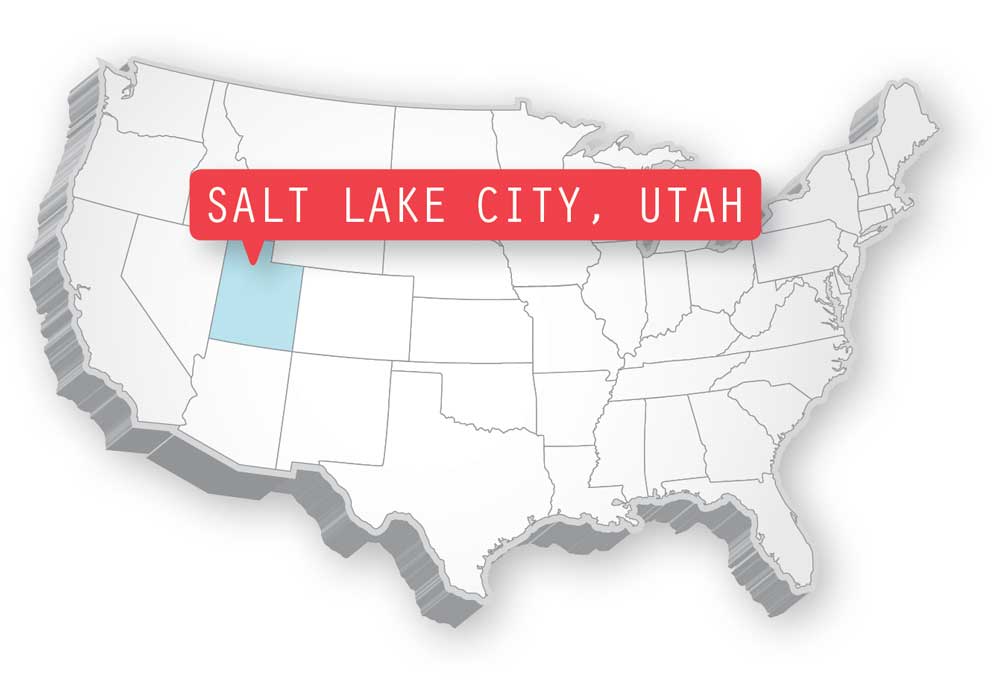
Did you Know?
Salt Lake City is located in a mountain valley with the Wasatch Mountains to the east and north. The city is situated on land once covered by the prehistoric Lake Bonneville, which existed within portions of Utah, Nevada and Idaho. Salt Lake’s official elevation is 4,330 feet above sea level.
In the North Visitors’ Center, we saw the 11-foot statue of Jesus known as “Christus,” by Danish sculptor Bertel Thorvaldsen. There’s also a 14-square-foot replica map of 1st century Jerusalem that shows the layout of the city during New Testament times and 12 life-size paintings by German artist Heinrich Hofmann depicting scenes from the life of Christ. On the lower level, several displays explain the Book of Mormon.
On our first visit to Salt Lake City several years ago, Jim dropped me off at the Family History Library while he ran some errands. I was curious about my ancestors, but knew I’d never have the patience to research microfilm in county courthouses or headstones in cemeteries. I was hoping to get lucky with the world’s largest genealogical library. After I watched an introductory movie, a guide helped me with my research. After going back several generations on my father’s side, the guide noticed that a branch of my family tree had already been filled in. She said, “We may find out you are royalty. Records weren’t kept this far back for ordinary citizens.” In the time it took my husband to get a haircut, the guide helped me trace my ancestors back to 1185 in Norfolk, England. I was thrilled to be a descendent of a knight, Sir Richard Heydon, who died in 1370. With that kind of success on my first visit, I had high hopes for the second. Unfortunately, the results from the second attempt weren’t as exciting, but it was enough to rekindle my interest in genealogy.
Salt Lake City is a great city to explore under any circumstances, but we found two ways that added to the adventure at an affordable price. The first was Urban Adventure Quest, a smartphone app that led us on a scavenger hunt to top sites in the downtown area. We downloaded the app and headed back downtown on Friday morning to start our urban adventure. It’s not a spoiler alert to say we visited Temple Square again, Salt Lake’s No. 1 tourist attraction. What would spoil the fun is if I told you too much about the clever puzzles we had to solve to win points and find our next destinations. Don’t worry; my lips are sealed. Suffice it to say our walking tour took us to Temple Square, the State Capitol and several other interesting locations. We made a conscious decision not to hurry through it for a fast time. Instead, we thoroughly enjoyed the unusual journey, taking time to appreciate each step along the way.
The second way to explore the area is with the Visit Salt Lake Connect Pass that offers admission to 13 different attractions for one price. The pass can be purchased for use on one, two or three consecutive days, or for a full year. With our three-day pass, we visited six attractions, starting with Red Butte Garden. Located on 100 acres near the University of Utah, it has more than 21 acres of developed gardens and 5 miles of hiking trails that wind through an extensive natural area. The vegetation and landscaping in the Water Conservation Garden were especially inspiring to those of us who live in drought-prone states. There were plenty of flowering plants in the Four Seasons, Rose and Fragrance Gardens to admire in the summertime. We missed the 450,000 springtime blooming bulbs, which includes 230,000 daffodils. That’s reason enough to return in the spring.
The Utah Museum of Fine Arts at the University of Utah (UMFA) has nearly 20,000 original works of art, from ancient objects to contemporary works. In the Modern and Contemporary Art gallery, I was fascinated by two pieces. In her “Discarded Memories” sculpture, Chakaia Booker “slices, twists, weaves and rivets discarded tires to emphasize their radial patterns that are akin to African textiles and body decoration.” Angela Ellsworth decorates her “Seer Bonnets” with “thousands of pearl-tipped corsage pins that create beautiful exteriors and sharp, dangerous interiors.” In other parts of the museum, art from America, Africa, China, Europe, South Asia, the Pacific and ancient cultures are featured.
Also located on the University of Utah campus, the Natural History Museum of Utah is housed in a stunning 163,000-square-foot building. Among its 30,000 specimens, the paleontology collection features two new species of horned dinosaurs found in southern Utah in 2000 and 2007. Other collections showcase Native American artifacts, insect specimens and minerals. In addition to more than 41,000 square feet of gallery and education space, the state-of-the-art facility has research laboratories, conservation labs, collection storage and administration areas.
Our pass also included a meal at the Lion House Pantry in Temple Square. The Lion House was built in 1856 by Brigham Young, second president of the LDS Church. Now it’s a cafeteria-style restaurant that serves home-style fare from recipes passed down through generations.
For More Information
Antelope Island State Park
801-773-2941Clark Planetarium
385-468-7827Hill Aerospace Museum
801-825-5817Natural History Museum of Utah
801-581-4303Pony Express RV Resort & Campground
877-421-7002Red Butte Gardens
801-585-0556Utah Museum of Fine Arts
801-581-7332Utah Olympic Park
435-658-4200
The Clark Planetarium appeals to people of all ages who want to learn about science and space. In the IMAX theater, we saw “Dream Big: Engineering Our World.” The movie aims to transform how we think about engineering and inspire kids to become innovators who will improve the lives of people around the world.
On the last day of our three-day pass, we drove 25 miles to Park City to visit Utah Olympic Park. The Joe Quinney Winter Sports Center houses two museums, the George Eccles Salt Lake 2002 Olympic Winter Games Museum and the Alf Engen Ski Museum, with memorabilia from the Olympics and Utah’s ski history. The 389-acre venue was built for the 2002 Winter Olympics. It has six Nordic ski jumps, a 1,335-meter sliding track with five start areas, a freestyle aerials winter training and competition hill, and a 750,000-gallon training pool. We watched aerial skiers train on the jumps and land with a splash in the pool, perhaps preparing for a future Winter Olympics. At one end of the pool, climbers scaled a tall overhanging climbing wall called the Psicobloc Wall. These “deep water solos” also ended with a splash. All of it was entertaining to see.
There’s more to do than watch other people have fun at Olympic Park. Activities are available for various skill levels, ages and bravery thresholds. Thrill seekers can speed downhill at 60 mph on the Comet Bobsled Ride on the sliding track. Other summer options include extreme tubing, zip lines, ropes courses, an alpine slide and a scenic chairlift. We chose the Canyon Adventure Course, an intermediate-level ropes course designed to test our ability with log traverses, swinging elements and problem-solving features while harnessed to a wire 25 feet in the air. It was harder than I expected with my short legs, but doable — and lots of fun.
Antelope Island is the largest of 10 islands in the Great Salt Lake. When water levels are low, it’s actually a peninsula. Antelope Island State Park covers the entire island, which has 46 RV sites (no hookups). The island is known for its natural scenic beauty and abundant wildlife, including free-ranging American bison, pronghorn antelope, bighorn sheep and mule deer. It’s also one of the most popular birding destinations in Utah.
The Fielding Garr Ranch is located on the southeastern portion of Antelope Island at Garr Springs, which is one of the strongest and most consistent springs of the 40 known springs on the island. The ranch was established in 1848 by Fielding Garr to manage cattle and sheep for the LDS Church. Today it’s a demonstration ranch where visitors can explore the ranch house, stables, blacksmith shop and other buildings.
After wandering through the exhibits, we left our dinghy vehicle at Fielding Garr Ranch and rode our mountain bikes on the South Island Trail to Unicorn Point at the southern tip of the island. There was no fence between us and hundreds of bison that live in this area. Most of them were near the shore, but occasionally we’d see one closer to the trail. They aren’t usually aggressive, but they are wild animals and may be dangerous. We were careful not to disturb them.
If you decide to mountain bike on Antelope Island, beware of goatheads, those nasty little thorns that can wreak havoc on tires. Between our two bikes, we probably had close to a hundred of them. Fortunately, we had tubeless tires with a sealant, which held for three of the tires. The other one waited until the following morning to go flat.
Our visit to Salt Lake would not be complete without eating at the Red Iguana. The restaurant’s tagline is “Killer Mexican food that’s worth the wait.” We waited outside on the sidewalk for about 30 minutes on a Sunday night. It was truly worth the wait. The pistachio mole over chicken was my favorite restaurant meal of the entire year!
Based on how many times I’ve heard Jim tell friends about our tour of the Hill Aerospace Museum, I’d say that was the highlight of our Salt Lake visit for him. The museum is located on the northwest corner of Hill Air Force Base. The exhibits include more than 90 military aircraft, missiles, aerospace vehicles and artifacts in the galleries and on the grounds. While the signs in front of each piece provide a good explanation, our tour guide brought it all to life. Volunteer Rocky Olson was a decorated Vietnam veteran who also worked for the U.S. Department of Defense. Jim bought Olson’s book Sgt. Rock: Last Warrior Standing, “The true story of a sole survivor … the soldier who would not die.” It was a fascinating read.
In retrospect, I can’t imagine why we waited so long to return to this wonderful city.
 Mary Zalmanek and her husband, Jim, enjoy traveling in their 2019 Winnebago Vista LX when they are not at home in Colorado. Mary loves to cook and entertain, even in the small confines of her motorhome. She shares her favorite recipes on her food blog cookinginaonebuttkitchen.com
Mary Zalmanek and her husband, Jim, enjoy traveling in their 2019 Winnebago Vista LX when they are not at home in Colorado. Mary loves to cook and entertain, even in the small confines of her motorhome. She shares her favorite recipes on her food blog cookinginaonebuttkitchen.com

